with photos by Chris Manley, Lynn Fomison, Pat Turner, Peter Eeles, Robin Turner and Tim Norriss.
This report details the butterflies and moths observed on a trip made to northern Greece from 7th to 13th June 2009. The members of the party were Chris Manley, Lynn Fomison, Peter Davey, Peter Eeles, Robin and Pat Turner, and Tim Norriss.
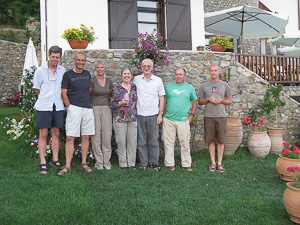
We were based in northern Greece, in the delightful village of Ano Poroia, situated on the lower slopes of Mount Kerkini and very close to the Bulgarian and Macedonian borders. For those of you wishing to visit the area, there are many cheap flights to the area from Gatwick, Heathrow and most major UK airports.

A map showing the key sites we visited is shown below.

Each site we visited is identified with a letter (A through Q) in this report, the details of which are:
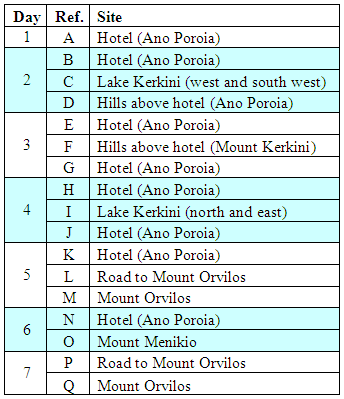
We took an early morning flight from Gatwick and arrived at Thessalonika airport around midday. A mix up with our vehicle booking meant we had 2 cars rather than the minibus we ordered. Undeterred, we headed north to our base - the wonderful Hotel Nastou in Ano Poroia, nestled in the foothills of Mount Kerkini. We were met by our host, a wonderful and generous chap called Demitris, whose command of the English language was as good as our Greek - yet somehow we managed to communicate quite effectively. The hotel itself was first class and highly recommended to anyone thinking of making a similar excursion. The spacious rooms were stunning as were the views, with all rooms overlooking Lake Kerkini and the hills beyond.
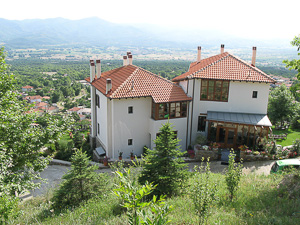

Given our relatively-late arrival, expectations of seeing a good number of butterflies were low as we wandered in the vicinity of the hotel and yet we managed to notch up 23 species in just over an hour! It was good to reacquaint ourselves with some old friends from previous trips - namely Scarce Swallowtail (Iphiclides podalirius), Black-veined White (Aporia crataegi), Eastern Bath White (Pontia edusa), Sloe Hairstreak (Satyrium acaciae), Knapweed Fritillary (Melitaea phoebe) and Queen of Spain Fritillary (Issoria lathonia).
-2.jpg)
.jpg)
We were also treated to a number of Large Tortoiseshells (Nymphalis polychloros) that were found flying around the elms that sat in a lane just below the hotel and we managed to find an abandoned larval web with the shed larval skins still intact on the elm branches. Lesser Spotted Fritillary (Melitaea trivia) was seen in good numbers in the lane and we also came across singletons of Southern Comma (Polygonia egea) and Lattice Brown (Kirinia roxelana), the latter being well-camouflaged as it sat motionless on a tree trunk. We also came across a Grayling species that caused much debate (and still does!). Unfortunately, several species of Grayling found in the area can only be distinguished by a thorough examination of their genitalia. The single Grayling we found was spared any embarrassment - whether he or she was a Delattin's Grayling (Hipparchia volgensis) or a Southern Grayling (Hipparchia aristaeus) we shall never know. All we know is that it was a pleasure to meet you!
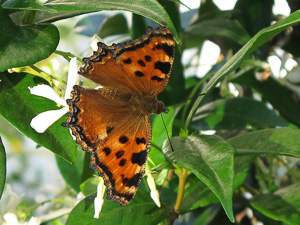

.jpg)
But the highlight, by far, was being surrounded by an exceptionally prolific emergence of Nettle-tree Butterfly (Libythea celtis), the sole European representative of the Libytheidae family. This family represents the "snout" butterflies, as they are known, for their labial palps are excessively-long and can appear quite strange when seen close up. Looking like a Small Tortoiseshell in flight, they were definitely one of the highlights of the trip - and always a pleasing sight to come back to when we returned to the hotel on the days that followed. We'd quite often find half a dozen in the car park taking minerals from areas of moist ground.
 RT-3707.jpg)
There were a couple of interesting moth species on the wing too, the Nine-spotted (Amata phegea) was unmistakable, and a single stunning and utterly exotic Croatian Bee Hawk (Hemaris croatica), similar in design to our Broad-bordered Bee Hawk, but with opaque olive green scales on the forewing in place of the transparent panels, an olive green thorax, and opaque orange-red hindwings. The Humming-bird Hawk was seen and perhaps unsurprisingly was ubiquitous throughout our stay.
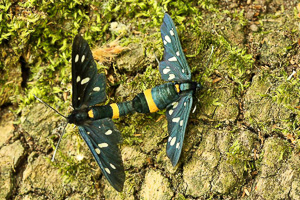
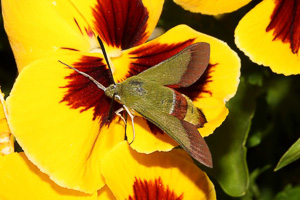
Several moth traps were deployed at the hotel overnight, a 300 watt UV bulb from one bedroom balcony and a 125 watt MV bulb sited in the car park. Spotlights within the car park area produced moths too. Our first night yielded 79 species in all. Moths that tend to be seen as immigrants in the UK included: Uresiphita gilvata, Blair's Mocha (Cyclophora puppillaria), Sub-angled Wave (Scopula nigropunctata), Plumed Fan-foot (Herminia plumigeralis), Oak Yellow Underwing (Catocala nymphagoga), Passenger (Dysgonia algira), Geometrician (Grammodes stolida), Dewick's Plusia (Macdunnoughia confusa), Ni (Trichoplusia ni), Spotted Sulphur (Emmelia trabealis), Small Marbled (Eublemma parva), Bordered Straw (Heliothis peltigera), Clancy's Rustic (Platyperigea kadenii), Pale-shouldered Cloud (Actinotia hyperici), Latin (Callopistria juventina), Gypsy (Lymantria dispar), and Hoary Footman (Eilema caniola). Some rarer UK residents included: Cnaemidophorus rhododactyla, Cynaeda dentalis, Udea fulvalis, Pyrausta cingulata, Lace Border (Scopula ornata), Least Carpet (Idaea vulpinaria), Portland Ribbon Wave (Idaea degeneraria), Heart (Dicycla oo) and Lesser-spotted Pinion (Cosmia affinis). The wings of the Giant Peacock (Saturnia pyri) were found on the ground beneath one of the car park spotlights. There were some colourful southern European Lepidoptera too: Epinotia festivana, Pyralis regalis, Epascestria pustulalis, Ecpyrrhorrhoe rubiginalis, Odonestis pruni, Nychiodes obscuraria, Peribatodes correptaria, Eucrostes indigenata and Rhyparia purpurata.
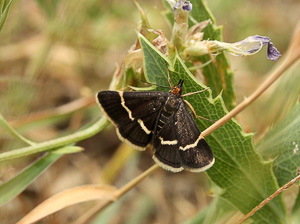
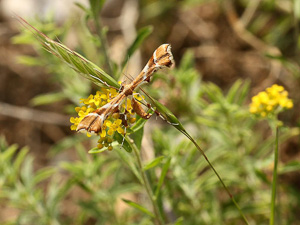
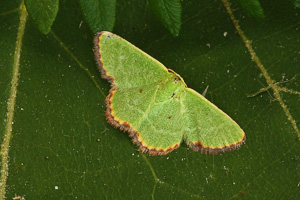
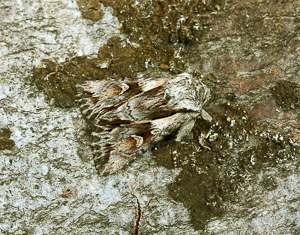
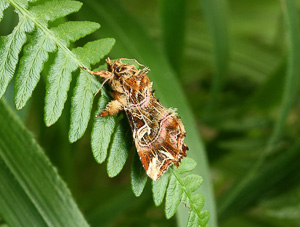
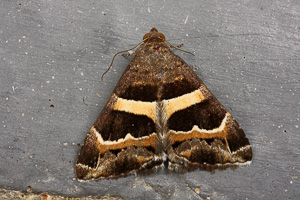
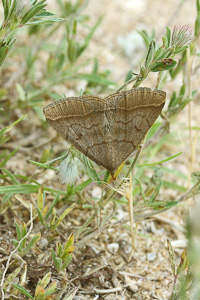
The task of examining and identifying the relatively large numbers of moths, many quite unfamiliar, proved as usual to be a time-consuming process. By the time breakfast was served, many of the pots we had brought with us were occupied with specimens for further study or photography. The tiny room fridges were commandeered and the hotel supplied drinks and snacks therein jettisoned to make way for the pots, all in the name of science.
Site A - Hotel (Ano Poroia)
(In the tables showing the butterfly day listing, a red cell represents an unconfirmed sighting.)

In preparing for the trip, we decided to contact Tristan Lafranchis, the well-known European butterfly expert, author of "Butterflies of Europe" (an essential field guide for a trip like this - we had 4 copies between us!) and, most importantly, a resident of Greece. Tristan had kindly given us a few tips for sites to go and visit. Areas around Lake Kerkini were recommended and, given that we were only 20 minutes drive away, decided that we should make this our first outing.
Before setting off, we had a quick wander around the hotel grounds, which resulted in a few more "firsts" for the trip, including Cleopatra (Gonepteryx Cleopatra), Ilex Hairstreak (Satyrium ilicis), Sooty Copper (Lycaena tityrus) and Balkan Marbled White (Melanargia larissa). After stopping in Ano Poroia village to pick up some local produce for lunch, we were on our way.
.jpg)
.jpg)
It wasn't long before we arrived at our first stop on the western side of Lake Kerkini. We were hoping to find Large Copper and Little Tiger Blue, but neither was to be found. We did see our first Swallowtails (Papilio machaon) flying around, occasionally nectaring on Thistle, together with a good number of Clouded Yellow (Colias crocea). This included a mating pair, where the female was of the form helice, which is largely grey-white in colour on the upperside rather than the usual yellow.
-8177.jpg)
 RT-3932.jpg)
A number of Southern White Admirals (Limenitis reducta) were flying along the edge of the road, occasionally stopping to give good views. Other "firsts" included Lang's Short-tailed Blue (Leptotes pirithous), Powdered Brimstone (Gonepteryx farinose), Purple-shot Copper (Lycaena alciphron) and Wood White (Leptidea sinapis). An interesting micro, pictured here, with extraordinary scale tufts, turned out to be Hapsifera luridella. A Four-spotted was disturbed from roadside herbaceous tangle in one place. New Forest Burnet flew over scrubby grassland.
.jpg)
 RT-4115.jpg)
.jpg)
.jpg)
We drove a little further around the western side of the lake. At our next stop we came across some promising meadows where some of the locals were picnicking, and where we decided to have lunch. We then took an early afternoon stroll into the surrounding meadows and came across a strong colony of Marbled Fritillary (Brenthis daphne), with several Spotted Fritillary (Melitaea didyma) also flying nearby.

After a spot of lunch we decided the heat was too much to bear - the lake and its surroundings acting like a sun trap, with almost no breeze to cool us down. We decided to retreat back to the hotel to investigate the surrounding mountainside.
The walk from the hotel started in a wooded area that gave is our first Yellow-banded Skipper (Pyrgus sidae) for the trip. Looking like a Grizzled Skipper from the upperside, the underside is a different matter altogether, with a striking yellow-orange band running across it. A little further on we came to a substantial track that wound its way up the mountain. Although butterflies were few and far between for the first 30 minutes or so, the track reached a plateau that allowed the areas beside the track to be explored. A few Swallowtails (Papilio machaon) were "hill topping" here, chasing one another in search of a mate.
 RT-4958.jpg)
One particular bend in the track was populated by some tall yellow-flowered bushes that attracted a host of butterflies. Among the very numerous Nettle-tree Butterflies (Libythea celtis) were various Graylings and Lattice Browns (Kirinia roxelana). A couple of very fresh White-letter Hairstreaks (Satyrium w-album) also put in an appearance and we managed our first sightings of Eastern Baton Blue (Pseudophilotes vicrama), Green Hairstreak (Callophrys rubi), Mazarine Blue (Cyaniris semiargus) and Silver-studded Blue (Plebejus argus), the latter looking completely out of place to those of us who have only found this species on heathland back in the UK. The only moths of note were the Purple-barred Yellow (Lythria purpuraria), plus the Pyralids: Evergestis aenealis and Synaphe moldavica. The short time we spent on the mountain was so productive that we vowed to make a return trip the following day.
-2.jpg
)
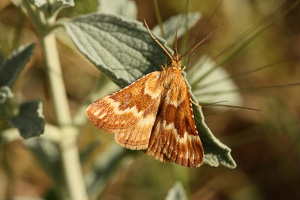
The moth trap tally exceeded 100 species on our second night. New species of note included: Dyspessa ulula, Herculia rubidalis, Pterothrixidia rufella, Aporodes floralis, Paracorsia repandalis, Palpita unionalis, Oak Hawk (Marumba quercus), Spurge hawk, Striped hawk, Eilicrinia trinotata, Ennomos quercaria, Olive-tree Beauty (Peribatodes umbraria), Chlorissa etruscaria, Cyclophora suppunctaria, Rhodostrophia discopunctata, Scopula submutata, Tawny Wave (Scopula rubiginata), Idaea politaria, Idaea albitorquata, Idaea ostrinaria, Idaea deversaria, Eupithecia breviculata, Scarce Dagger (Acronicta auricoma), Catocala conversa, Catocala nymphaea, Alchymist (Catephria alchymista), Aedia funesta, Pale Shoulder (Acontia lucida), Small Marbled (Eublemma parva), Glossodice polygramma, Spotted Clover (Protoschinia scutosa), Idia calvaria, White-spotted Pinion (Cosmia diffinis), Delicate (Mythimna vitellina), l-album Wainscot (Mythimna l-album), Feathered Ear (Pachetra sagittigera), Handmaid (Dysauxes ancilla), Dysauxes famula, Odites kolarella.
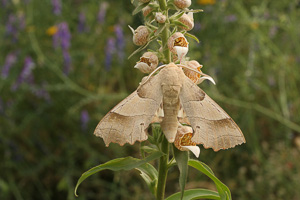
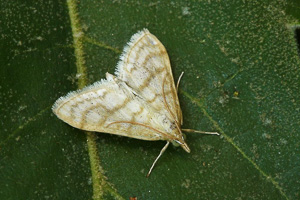
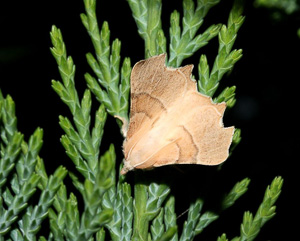
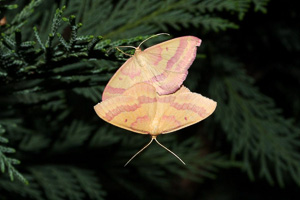
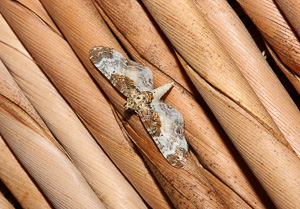
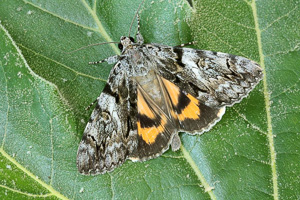
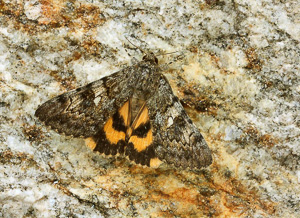
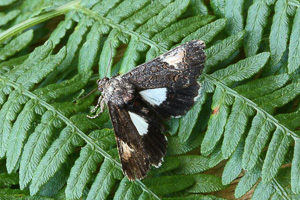
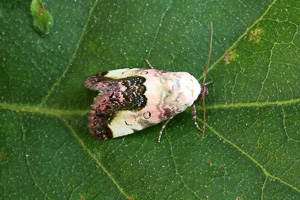

B - Hotel (Ano Poroia)
C - Lake Kerkini (west and south west)
D - Hills above hotel (Ano Poroia)
(In the tables showing the butterfly day listing, a green cell represents a new species for the trip.)
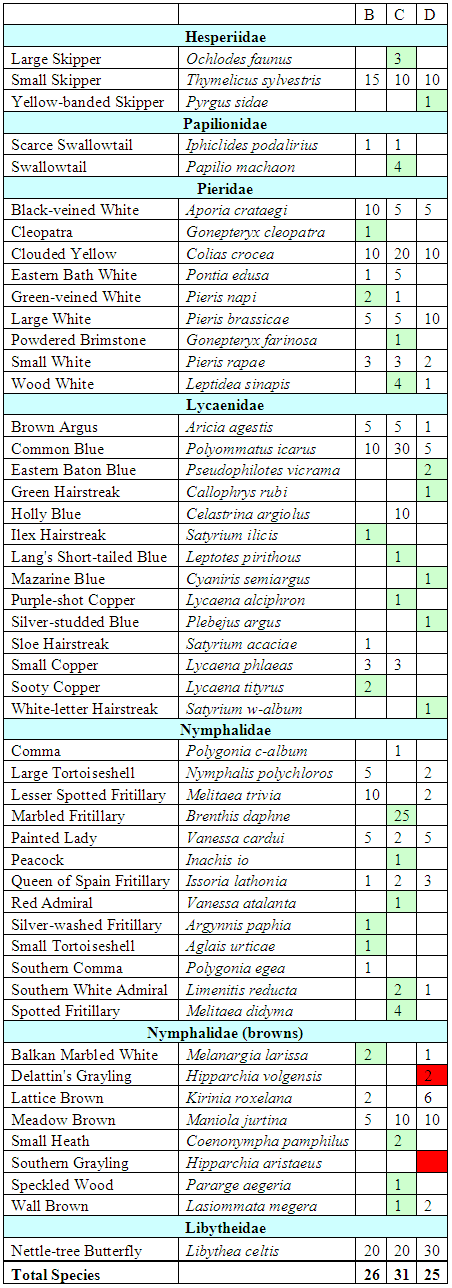
Knowing that we wouldn't be spending much time travelling today, we decided to first have a leisurely stroll in the area around the hotel to see what was about. As usual, the Nettle-tree Butterfly (Libythea celtis) was in good numbers and, in the lane below the hotel, we caught a glimpse of a very flighty Cardinal (Argynnis pandora) that stopped momentarily to feed on Thistle flowers, right next to a nectaring Scarce Swallowtail (Iphiclides podalirius).
.jpg)
In order to get further up the mountain than we managed the previous day, we decided to take the cars and soon reached the plateau reached by foot the previous day. The yellow-flowered bushes seen the previous day were still attracting good numbers of butterflies and we found a new Grayling species - either an Eastern Rock Grayling (Hipparchia syriaca) or a Woodland Grayling (Hipparchia fagi). As for Delattin's and Southern Graylings, these species can only be distinguished based on their genitalia.
.jpg)
Visiting this site earlier than the previous day resulted in much better numbers of White-letter Hairstreak (Satyrium w-album), Lattice Brown (Kirinia roxelana) and Nettle-tree Butterfly (Libythea celtis) - the latter rapidly being overlooked as they turned out to be one of the commonest butterflies of the entire trip. We also had our first and only sighting of a Purple Hairstreak (Quercusia quercus).
Having the cars allowed us to press on much further than we could ever have managed on foot. Despite some precarious moments, usually caused by a lack of any discernable track or an oversized rock, we managed to get to a significant plateau that was ours for the day, with no other soul in sight. As this new area opened before us, we could already see that the overflow from a water trough was acting as home to several different species of butterfly. Two species that were constantly in attendance were Large Tortoiseshell (Nymphalis polychloros) and Queen of Spain Fritillary (Issoria lathonia).
.jpg)
This site also had several Purple-shot Copper (Lycaena alciphron) in the area, including a newly-emerged female that obliged the photographers among us. Black-veined White (Aporia crataegi) was in good numbers and Clouded Yellow (Colias crocea) seemed ever-present. We also managed a few "one offs" and new species for the trip - including Dingy Skipper (Erynnis tages), Eastern Dappled White (Euchloe ausonia), Southern Small White (Pieris mannii) and Pearl-bordered Fritillary (Clossiana euphrosyne). Of the few moth species seen here, Holoscolia huebneri and Thisanotia chrysonuchella were noteworthy.
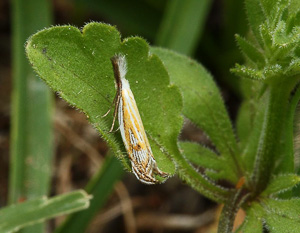
We thought the day held no more surprises as we returned to our hotel, but a few plants in the garden turned out to be some of the most productive of the entire trip - especially some flowering Marjoram that was host to a fresh White-letter Hairstreak which obliged the photographers for several minutes, alongside a Large Tortoiseshell (Nymphalis polychloros) and Southern Comma (Polygonia egea).
.jpg)
E - Hotel (Ano Poroia)
F - Hills above hotel (Mount Kerkini)
G - Hotel (Ano Poroia)
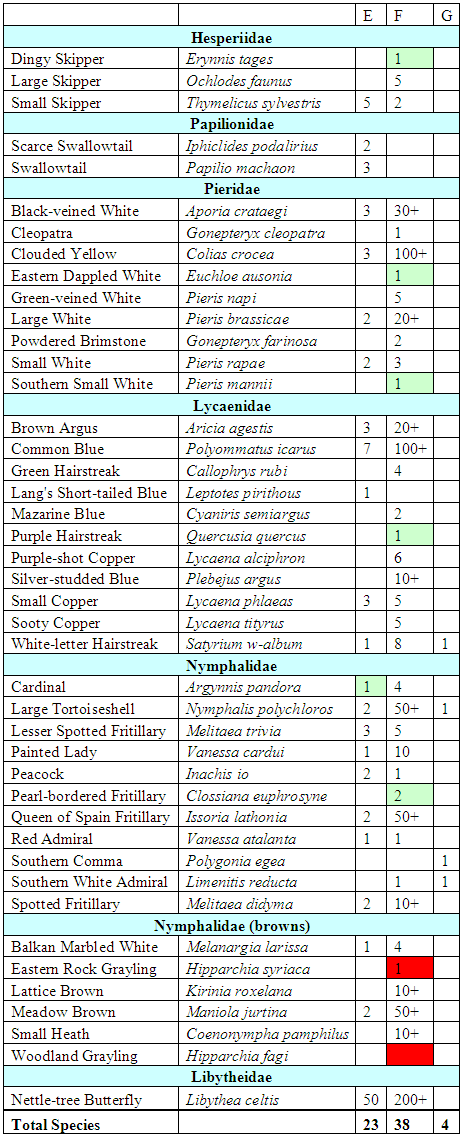
After consulting several maps (and the Internet), we decided to make a return trip to Lake Kerkini - but this time heading to the north-eastern side of the Lake - still hoping to find Large Copper and Little Tiger Blue. After a brief sortie of the hotel grounds, we were on our way.
As we got out of the cars, it quickly became obvious that, despite the area lying right next to a tributary of the lake, the ground was absolutely parched. Within a few minutes, however, we'd spotted our first Camberwell Beauty (Nymphalis antiopa) of the trip, flying around a woodland edge, its distinctive white fringe making it unmistakable in the dappled sunlight. Another new species for the trip was Short-tailed Blue (Everes argiades). Marbled Fritillary (Brenthis daphne) was also seen in good numbers, and several Knapweed Fritillaries (Melitaea phoebe) were also seen. Several full-grown and very colourful Spurge Hawkmoth larvae were also found feeding on the Spurge that was growing every few yards.
.jpg)
.jpg)
The other side of the tributary revealed a slightly different habitat, with several Spotted Fritillary (Melitaea didyma) being found in a corner of a field, and Tufted Marbled Skipper (Carcharodus flocciferus) being found in a lane running away from the main road.
.jpg)
.jpg)
We decided to eat our lunch next to some White Willows growing next to one of the lake tributaries, having been tipped off by one of our party that they'd seen an emperor of some sort - whether it was Freyer's Purple Emperor (Apatura metis) or Lesser Purple Emperor (Apatura ilia) was impossible to tell from a distance. As the group gathered, various binoculars and digiscopes came into action and we were soon treated to infrequent displays of the now-identified Freyer's Purple Emperor (Apatura metis) high in the willows. This species looked quite orange when in flight, but retained the characteristic "flit and glide" behaviour exhibited by all emperors. As we'd almost given up for the day, one of the emperors alighted on the willow we were resting beneath and sat there for a minute or so; it soon became clear that it was, in fact, egg-laying - the moment captured for posterity through a digiscope viewfinder! Despite the relative paucity of species seen, this was the perfect conclusion to the day - a sight we continued to discuss into the evening.
New and interesting moth species to the light traps included: Lamoria anella, Aporodes floralis, Etiella zinckenella, Oncocera semirubella, Euchromius superbellus, Xanthocrambus saxonellus, Pediasia contaminella, Evergestis aenealis, Pyrausta castalis, Sitachroa verticalis, Metasia ophialis, Essex Emerald (Thetidia smaragdaria), Middle Laced Border (Scopula decorata), Idaea filicata, Marbled Grey (Cryphia raptricula), Scarce Blackneck (Lygephila craccae), Rhynchodontodes antiqualis, Ni (Trichoplusia ni), Lamprosticta culta, Scarce Bordered Straw (Helicoverpa armigera), Chazaria incarnata, Small Mottled Willow (Spodoptera exigua), Latreille's Latin (Methorasa latreillei), Barrett's Marbled Coronet (Hadena luteago), Black V (Arctornis l-nigrum) and Meganola togatulalis.
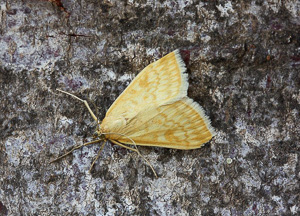
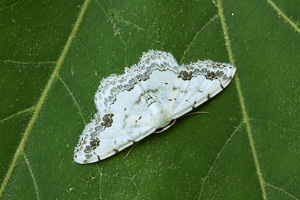
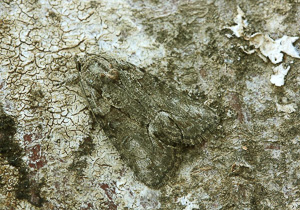
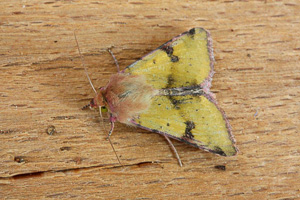
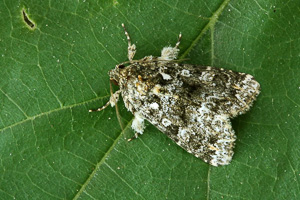
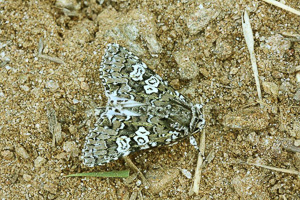
H - Hotel (Ano Poroia)
I - Lake Kerkini (north and east)
J - Hotel (Ano Poroia)
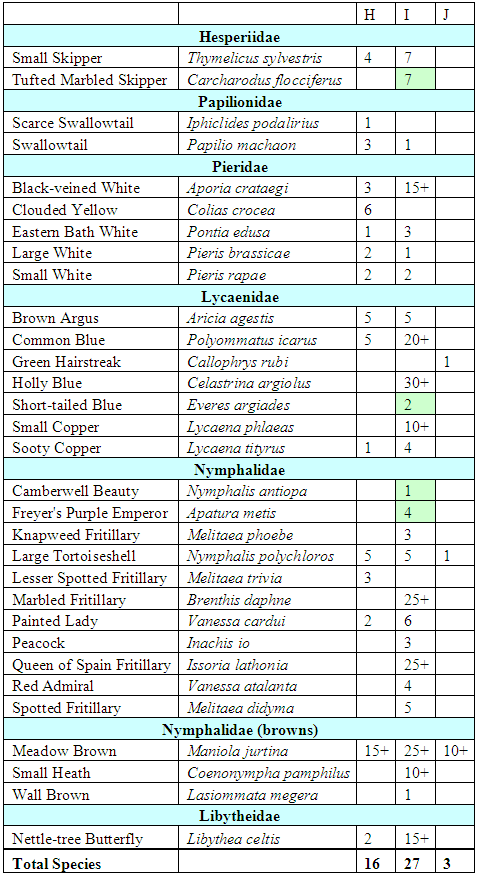
With half of the trip already over, there was much head scratching as we tried to decide what the best course of action was; having exhausted what the nearby mountains had to offer, and having found the area surrounding Lake Kerkini to be more-or-less a casualty of the scorching weather, we needed a "Plan B". The plan that emerged was to travel further afield. Referring back to the guidance from Tristan, we decided to head into a completely different mountain range, our target being Mount Orvilos some way to the east. With our excitement renewed, our first sighting of a Mallow Skipper (Carcharodus alceae) in the lane next to the hotel bode well for the day.
 RT-5019.jpg)
After an hour or so, we were at the base of the mountains that would be hosting us for the day. The terrain already looked quite different to that we had driven through, which was a promising sign, with woodland growing next to relatively-lush meadows. Before heading further into the mountain range we decided to take a short break at the side of the road. Sometimes it all just comes together - within seconds we had our first sighting of a Little Tiger Blue (Tarucus balkanicus), then another and, before we knew it, we found a mating pair that was quite happy to pose for the cameras.
.jpg)
This stop also revealed a significant colony of Ilex Hairstreak (Satyrium ilicis) that seemed to constantly flit around our heads, as well as excellent numbers of Chapman's Blue (Arodiaetus thersites) flying alongside them. We also found plenty of evidence of damage caused Gypsy Moth larvae in the area together with several larvae and pupae.
.jpg)


With such a promising start we decided to stop at the next suitable-looking habitat to have a proper look around. Within a few miles we were parked up and proceeded to explore the surrounding area - a woodland-lined riverbank with adjoining fields. We quickly realised that this was a perfect site for hairstreaks, with several species seen. Our hopes for a good day were confirmed as we saw 6 new species for the trip - the spectacular Eastern Festoon (Zerynthia cerisy) together with Anomalous Blue (Agrodiaetus admetus), Blue-spot Hairstreak (Satyrium spini), Eastern Wood White (Leptidea duponcheli), Great Banded Grayling (Kanetisa circe) and Hermit (Chazara briseis).
 RT-4783.jpg)
.jpg)
.jpg)
.jpg)
A few interesting moth species were found. These included the fascinating clear-window-winged Thyris fenestrella, plus several Catocala diversa resting on tree trunks within the woodland next to the river.
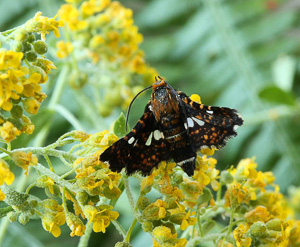
After a couple of hours, we decided that it was time to move on, despite the wind picking up. We headed into the mountains and soon came across another of the yellow-flowered bushes that we'd come across near to our hotel. This time, the bush was absolutely inundated with Painted Lady (Vanessa cardui), with literally hundreds congregating on what must have been the preferred nectar source for some distance.
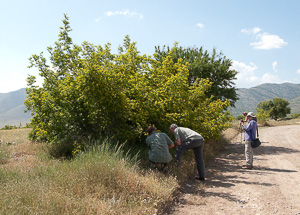
A little further on into the mountains, we reached our final stop for the day, a more-sheltered valley with promising meadows in the vicinity.
.jpg)
The blackthorn surrounding the meadows was particularly good for Sloe Hairstreak (Satyrium acaciae) and several Yellow-banded Skipper (Pyrgus sidae) were seen in the meadows. New species for the trip were Amanda's Blue (Agrodiaetus amanda), Berger's Clouded Yellow (Colias alfacariensis), Heath Fritillary (Mellicta athalia), Hungarian Skipper (Spialia orbifer), Marbled Skipper (Carcharodus lavatherae) and Small Blue (Cupido minimus). Of the moths walked up within the meadows and surrounding grassland, Evergestis sophialis and Loxostege aeruginalis were new for the trip. With the wind now making sightings and photography almost impossible, we decided to head back to the hotel.
.jpg)
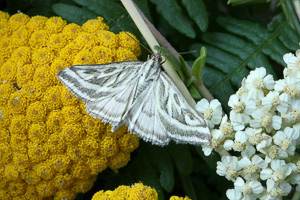
Eucosma metzneriella, Trachycera dulcella, Loxostege sticticalis, Ascotis selenaria, Proteuchloris neriaria, Watsonarctia casta, Dichagyris forcipula were new from the moth traps.
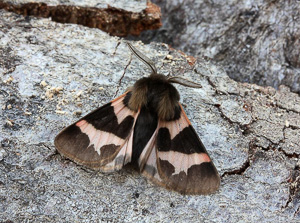
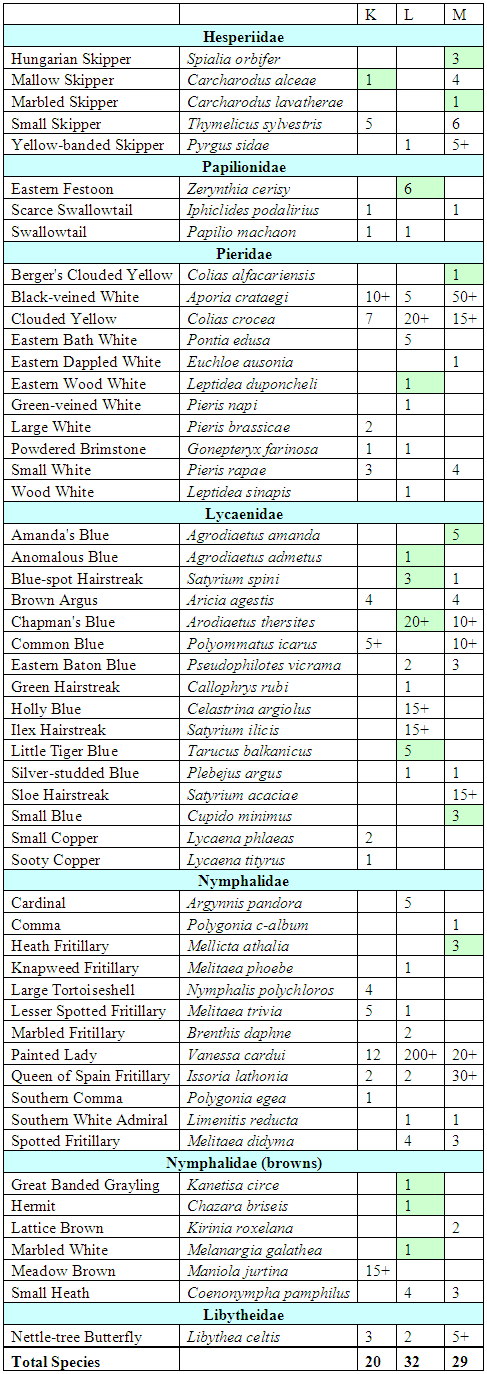
Given the success of the previous day, we decided to make another outing, this time even further afield, to Mount Menikio. Having arrived in the area, we navigated our way through several villages, before we finally found a route that would take us into the mountains. We stopped at the base of the mountains for a break and surveyed the hillside. A Camberwell Beauty (Nymphalis antiopa) flew up and over our heads as we got out of the cars and we immediately noticed a couple of Ilex Hairstreak (Satyrium ilicis) flitting around some Ilex bushes, from which this species gets its name.
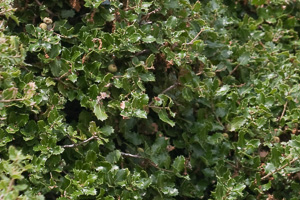
The more we looked, the more hairstreaks we found until we finally came across a line of bushes that had literally hundreds of hairstreaks surrounding them. The hairstreaks were so numerous they were difficult to count - the estimate of 500+ being on the conservative side. We also came across our first sighting of a Mountain Small White (Pieris ergane). A few Spurge Hawkmoth larvae were also found here.
 RT-3719.jpg)
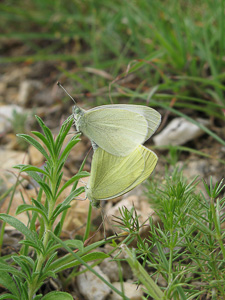
As we pushed on the track became more and more difficult to use and some of us had to walk in front of the cars to remove large rocks and fill in any major potholes! We eventually reached a gorge that looked promising and we stopped for lunch.

Both Scarce Swallowtail (Iphiclides podalirius) and Berger's Clouded Yellow (Colias alfacariensis) were regularly seen, with the former seen egg-laying on the plentiful Blackthorn.
.jpg)
-2.jpg)
Black-veined White (Aporia crataegi), Eastern Bath White (Pontia edusa) and Queen of Spain Fritillary (Issoria lathonia) were also in good numbers. Chapman's Blue (Arodiaetus thersites) was found in the company of 2 new species for the trip - Osiris Blue (Cupido osiris) and Turquoise Blue (Plebicula dorylas). A number of Southern White Admiral (Limenitis reducta) had also set up territories at various points along the gorge. Yet more Spurge Hawkmoth larvae were found and they were definitely one of the themes of the day.
.jpg)
The track ended a little further on, with a scrubby hillside before us.
.jpg)
Given the number of Spurge Hawkmoth larvae we were finding, we decided to play a game of "find the larva" on the Spurge that was growing all around. The winner managed to find a larva in 45 seconds! A Swallowtail (Papilio machaon) was also seen egg laying on Spurge - a surprising foodplant for this species.
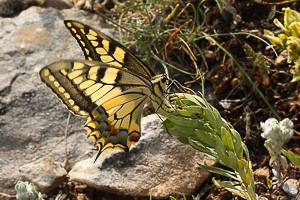
.jpg)
We also managed to add 2 more species to our list for the trip - Blue Argus (Aricia anteros) and Chequered Blue (Scolitantides orion). Of the moths encountered within the mountains, the following were of interest: Dichomeris marginella, Ancylosis cinnamomella, Cleta filacearia. We spent the remainder of the afternoon at the gorge where we had lunch before setting off back to the hotel.
.jpg)

New moth species overnight were: Hyperlais dulcinalis, Glossotrophia confinaria, Idaea pallidata, Idaea ostrinaria, Eupithecia spissilineata, Small Ranunculus (Hecatera dysodea), Broad-barred White (Hecatera bicolorata), Varied Coronet (Hadena compta) and Eidophasia syenitella.
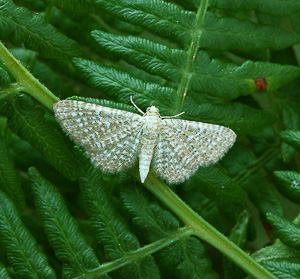
N - Hotel (Ano Poroia)
O - Mount Menikio
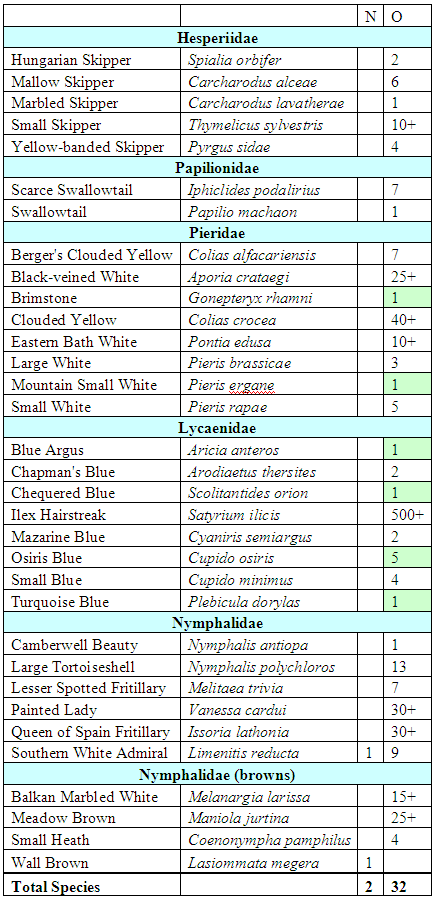
Choosing a site to visit for our last day was easy - our visit to Mount Orvilos two days earlier had been plagued by the wind, and so we decided to make a return trip. As we were to find out, this was the best decision we could possibly have made!
Now that we knew where we were heading, what sites to stop at on the way, and how long it was going to take to get there - we set off relatively early. Our first stop was at the same woodland-lined riverbank that we'd visited earlier in the week. Within seconds of emerging from the cars, we saw our first hairstreak on some tall white-flowering Dwarf Elders next to the riverbank.
.jpg)
Then we saw another, and another, until we were looking at 5 different species of hairstreak all jostling for position on the flowerheads - Blue-spot Hairstreak (Satyrium spini), Green Hairstreak (Callophrys rubi), Ilex Hairstreak (Satyrium ilicis), Sloe Hairstreak (Satyrium acaciae) and White-letter Hairstreak (Satyrium w-album). The White-letter Hairstreaks, in particular, were concentrated on one particular patch of flowers and, at one point, there were 5 or 6 individuals all sat on a single flower head. Reaching the site earlier in the day had definitely paid off, and provided concrete evidence of White-letter Hairstreaks nectaring primarily in the morning since we hadn't seen any on our previous trip here. The sight of so many hairstreaks together was definitely one of the highlights of the entire trip.
-2.jpg)
Wandering around the fields produced some more surprises. The Thistles attracted several species, making photography relatively-easy, including Niobe Fritillary (Argynnis niobe), a new species for the trip, Cardinal (Argynnis pandora) and Great Banded Grayling (Kanetisa circe). Several Eastern Festoon (Zerynthia cerisy) were also seen, including a mating pair. A number of delightful Little Tiger Blues (Tarucus balkanicus) were also flitting around the place.
.jpg)
-7850.jpg)
Several Idas Blue (Lycaeides idas), another new species for the trip, were also seen. We also came across what we believe was bear poo! This proved to be a magnet for several butterfly species, especially the blues, where Common Blue (Polyommatus icarus), Idas Blue (Lycaeides idas) and Eastern Baton Blue (Pseudophilotes vicrama) could all be seen feeding together. Moths seen in the gorge included: Euplocamus anthracinalis, Euplocamus ophisa, Zygaena carniolica, Sitochroa palealis.
.jpg)
.jpg)
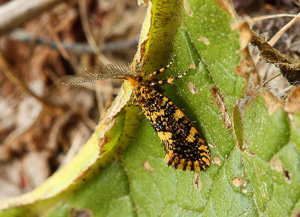
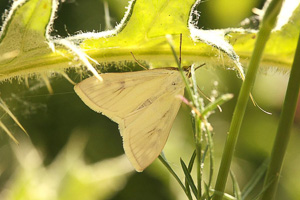
As you can imagine, we stayed in the area for some time and eventually moved on after a break for lunch. Before getting back in the cars, however, we did notice a good number of blues taking in minerals off the road. All in all, this was a butterfly heaven! Little did we know that the "piFce de rTsistance" was awaiting us as we headed on toward Mount Orvilos.
-2.jpg)
We stopped at the same meadows reached previously, although this time there was very little wind to spoil the enjoyment. The flowers in the meadow attracted a good variety of species, with Yellow-banded Skipper (Pyrgus sidae), Black-veined White (Aporia crataegi) and Queen of Spain Fritillary (Issoria lathonia) in good numbers. Most of the fun was spent distinguishing the various fritillaries flying around, which included Heath Fritillary (Mellicta athalia), Knapweed Fritillary (Melitaea phoebe), Lesser Spotted Fritillary (Melitaea trivia) and Spotted Fritillary (Melitaea didyma). Among them was a single Glanville Fritillary (Melitaea cinxia) - a new species for the trip.
Just off the track several blues were flying. Osiris Blue (Cupido osiris) and Small Blue (Cupido minimus) were flying together, putting our identification skills to the test. A single male Meleager's Blue (Meleageria daphnis), with its distinctive scalloped hindwing, gave us another new species for our list.
.jpg)
However, the possibilities of what lay further on tempted us away, although we only had to drive a few more hundred yards before the track came to an end.
.jpg)
It looked as if our day out had come to a premature end, when we noticed a path leading off into a gorge that was showered with sunlight - making a perfect sun trap and, as one would expect, very sheltered. Walking through a small corridor of bushes and trees, the path suddenly opened up into what can only be described as site akin to Shangri-La, the fictional paradise described in the book Lost Horizons. Within seconds we were greeted by literally hundreds of butterflies. With every footstep we'd come across something new, to the point of the spectacle becoming completely ridiculous with butterflies literally getting in our way as we tried to push on up the gorge. Many of the species we had already seen during the trip were also found here, including a mating pair of Mazarine Blue (Cyaniris semiargus).
 RT-5728.jpg)
To find Pearl-bordered Fritillary (Clossiana euphrosyne) flying alongside Adonis Blue (Lysandra bellargus), a new species for the trip, seemed so strange when the latter species is confined to chalk downland back home. A shout of excitement came as we saw our first "Erebia" for the trip - a colony of Woodland Ringlet (Erebia medusa). This magical place revealed more new species for us including Orange-tip (Anthocharis cardamines), Duke of Burgundy (Hamearis lucina), Green-underside Blue (Glaucopsyche alexis), Iolas Blue (Iolana iolas) and Pearly Heath (Coenonympha arcania).
-2.jpg)
.jpg)
-2.jpg)
After a couple of hours and exhausted from the excitement, we eventually made our way back. As we reached the cars, a female Clouded Apollo (Parnasius mnemosyne), yet another new species for the trip, was spotted. She had obviously mated since her abdomen had a "sphragis" attached, a kind of "chastity belt" that is glued onto the female by the male to prevent the female from mating again. We came across a few nice macro-moth species too in this prime locality: Slender Scotch Burnet (Zygaena loti), Oblique Striped (Phibalapteryx virgata) and Grass Rivulet (Perizoma albulata).
.jpg)
Two new moth species seen overnight were new for the trip: Sorcerer (Aedia leucomelas) and Mythimna anderreggii.
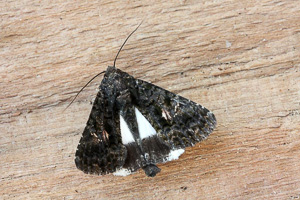
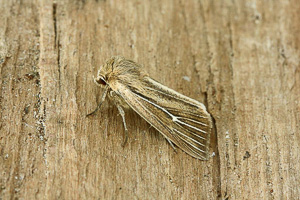
Lepidoptera-watching really doesn't get much better than this! With 84 butterfly species seen on our last day, this was the perfect end to our trip.
P - Road to Mount Orvilos
Q - Mount Orvilos

It isn't possible to separate Delattin's Grayling from Southern Grayling, and Eastern Rock Grayling from Woodland Grayling. All 4 species are listed below, although only 2 species will have been seen. The total number of species given takes this into account.
